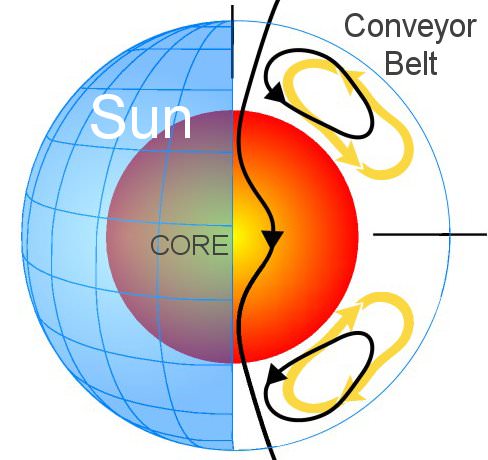[/caption]
The Sun seems to finally be waking up in earnest from the long slumber of the past cycle. Solar cycles tend to last on average about 11 years, but the last cycle – solar cycle 23 – was 12.5 years long. The cause of the most recent lull in the Sun’s activity is somewhat enigmatic, but it may be explained by the “conveyor belt” of plasma that circulates in the Sun’s chromosphere and photosophere. Just how far this conveyor belt of plasma extends underneath the Sun may heavily influence the duration of solar cycles.
In a recent paper published in Geophysical Research Letters, Dr. Mausumi Dikpati of the High Altitude Observatory National Center for Atmospheric Research in Boulder, Colorado and her team modeled data from the Mount Wilson Observatory for the duration of the last solar cycle. When they analyzed and modeled surface Doppler measurements of the flow of plasma currents that course underneath the surface of the Sun, they discovered that the flow extended all the way to the poles.
This is in contrast to data from previous, average-length solar cycles, in which the meridional plasma flow – or the Sun’s conveyor belt – flowed only to about 60 degrees latitude. This flow is not unlike thermohaline circulation here on Earth, in which the ocean transports heat around the globe.
Dr. Dikpati said in an email interview, “This is the first time that the Sun’s conveyor-belt has been measured accurately enough for two consecutive cycles (cycles 22 spanning approximately 1986-1996.5 and cycle 23 spanning 1996.5-2009). From these data we now know that cycle 22 had a shorter conveyor-belt reaching only to 60-degree latitude, while cycle 23 had a long conveyor-belt extending all the way to the pole.”
The cycles of the Sun are intricately linked to the magnetic field permeating our nearest star. Gigantic loops of the magnetic field of the Sun are what cause sunspots, and as the contours of the magnetic field change over the cycle of the Sun, more or fewer sunspots are seen, as well as solar flares and other activity. There is always a lack of sunspots between the cycles, but the minimum at the end of cycle 23 was unusually long.
The conveyor belt of plasma flowing in the chromosphere and photosphere essentially drags along with it the magnetic flux of the Sun. Because the extent of the conveyor belt reached a higher latitude, it took the magnetic flux longer to return to the equator, resulting in the delay of sunspots marking the onset of cycle 24.
Dr. Dikpati and her team determined that it wasn’t the speed of the flow of plasma conveyor belt that lengthened the solar cycle, but the extent into higher latitudes, and slower return to the equator. Though the speed of the conveyor belt was a bit higher than usual over the past five years, it also stretched much further than during a normal cycle.
Dr. Dikpati said of using data from previous solar cycles to better refine their model of the conveyor belt:
From the same data source (Mount Wilson data from Roger Ulrich) there is evidence of a short conveyor-belt in cycles 19, 20 and 21 also. All these cycles had periods (10.5 years) like cycle 22. Back beyond that we are hoping that others in the community will search for evidence of the latitudinal extent of the conveyor-belt in even earlier cycles. In fact, theory of the conveyor-belt in high-latitudes indicates that a shorter conveyor belt should be more common in the Sun, rather this long conveyor belt in cycle 23 may be the exception. There is already evidence from Mount Wilson data that, at the start of cycle 24, the conveyor-belt is shortening again, suggesting that cycle 24 is going to be more like cycles 19 – 22 in length.
By getting a better model of the interplay between the plasma flow and the Sun’s magnetic field, solar scientists may be able to better predict and explain the length of future and past solar cycles.
Dr. Dikpati said, “The conveyor belt also governs the memory of the Sun about its past magnetic features. This is an important ingredient for building prediction models for solar cycles.”
Source: Geophysical Research Letters, email interview with Dr. Mausumi Dikpati

